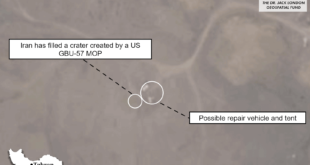Iran has set up centrifuges in two underground nuclear plants and will test them soon as it moves towards the industrial-level enrichment of uranium in defiance of UN demands, diplomats told ÐFÐ . “The Iranians have put together at least two cascades” of 164 centrifuges, said a diplomat who closely monitors both Iran and the Vienna-based UN watchdog International Atomic Energy Agency (IAEA).
Â
“It is a matter of hours, or of days, before the Iranians test the centrifuges on a vacuum, prior to putting in the UF6 (uranium hexafluoride) gas used to make enriched uranium,” said the diplomat on condition of anonymity.
A second diplomat said he doubted the Iranian leaders would wait as long as the anniversary celebrations for the Islamic revolution on February 11, when they were expected to make a major announcement on their nuclear programme.
The diplomats were speaking after reports last week that Iran has begun the installation of 3,000 centrifuges in a huge underground bunker at its main nuclear facility in the central town of Natanz.
IAEA inspectors were in Natanz last week.
The escalation in the international showdown over an Iranian nuclear programme which the United States says hides a secret weapons programme comes after the UN Security Council imposed sanctions in December to force Tehran to halt enrichment.
Washington has said it will await a report from IAEA chief Mohamed ElBaradei on Iran’s nuclear programme, expected to be released on February 22, before drawing any conclusions about Iran’s reported activities.
Iran’s envoy to IAEA, Ali Asghar Soltanieh, said on Saturday that the country continues to install uranium enrichment centrifuges but refused to give the timetable and details.
“Of course, we planned for (the installation of) additional centrifuges and we continue the work,” Soltanieh told a press conference after several ambassadors from IAEA non-aligned countries toured the central nuclear site of Isfahan.
Over the past months, Iranian officials have declared that the country was set to complete the installation in Natanz by the end of the current Iranian year (March 20) but experts think it may take longer.
Iran is building cascades in units of 164 centrifuges each and already has two such cascades running above-ground at a pilot enrichment plant at Natanz, producing only small amounts of enriched uranium.
But 3,000 centrifuges in the underground plant, protected in a bunker from possible air attack, could produce enough highly enriched uranium for one bomb in nine to 11 months, the London IISS think-tank has said.
Iran has told the IAEA it eventually wants to install over 50,000 centrifuges in Natanz.
Iran could be only two or three years away from being able to produce a nuclear weapon, IISS director John Chipman said last week.
Diplomats said Iran had last week stopped UN inspectors from installing surveillance cameras at the underground Natanz site, where the Iranians had announced the start of preliminary work in February 2006.
The Iranians are “not allowing the IAEA to install the cameras inside the cascade halls in Natanz,” keeping “the installation of cameras only outside the cascade halls, which will not enable the IAEA to monitor the entire uranium enrichment process,” a diplomat said.
The IAEA monitors the above-ground pilot site with cameras and is entitled to the same presence at the underground facility.
But the Iranians “have not yet introduced nuclear material (feedstock uranium gas) into the centrifuges at the underground site, so there is still time” to get IAEA access, another diplomat said.
 Eurasia Press & News
Eurasia Press & News



